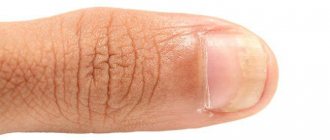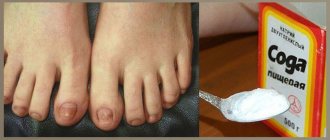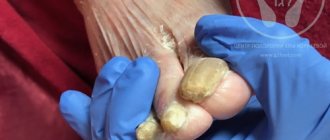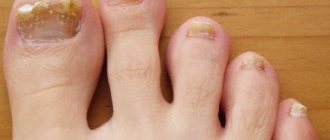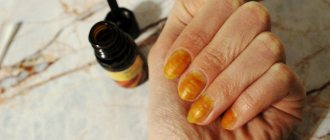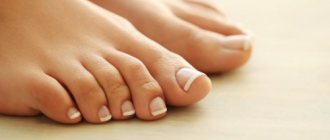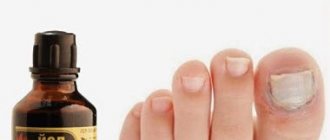August 13, 2018
Averyanova Sveta
Aggressive mushrooms that attack humans are not at all an invention of Hollywood cinema. It happens that people don’t even suspect that they are constantly being attacked by very unfriendly microbes that readily invade the body and gradually poison it with toxins. Children are no exception; toenail fungus is a common occurrence in children.
Causes and factors for the appearance of mycoses
The insidiousness of the infection is that the spores of the fungus that causes mycoses are found everywhere: in the soil, indoors, wherever it is warm, damp and dark. When dried, they are stored for a long time and can withstand temperatures from –50 to +70ºС. A baby can become infected in his own room if one of his close relatives is a carrier of the infection.
Children aged 1 year, whose thermoregulation system is not yet balanced, often have wet hands and feet, and these are good conditions for the development of mycoses. At risk are sick children whose immune systems are unable to cope with the attack of fungi. Factors that provoke the disease include:
- Frequent visits to the bathhouse, sauna, water park without shoes.
- Wearing someone else's shoes, socks, tights. The fungus can persist for a long time in winter shoes and penetrate the skin if the body's defenses fail.
- Tight shoes and boots made of artificial, non-breathable material - in them the fungus penetrates the skin and spreads much faster.
- Wearing shoes out of season.
Infection can result from both hypothermia of the feet and wearing insulated shoes indoors for a long time. It is very harmful to walk in boots from a cold room to a warm one several times. - The presence of wounds and abrasions on the skin: to prevent infection, any damage must be treated promptly.
- Improper nail care. Nails that are too long or short or damaged increase the risk of the disease.
- Cardiovascular diseases, diabetes. The latter increases the risk significantly.
- Lack of vitamins, excess carbohydrates in the diet.
- Taking antibiotics for a long time.
Causes of fungal infection
A healthy nail is able to resist the penetration of pathogenic fungi. Infection occurs through contact with a carrier, using shared hygiene items, or visiting public places, especially with high humidity. Factors that weaken local and general protective forces are the following:
- past infectious diseases: mononucleosis, tonsillitis, herpes, etc.;
- long-term antibacterial therapy;
- injuries to the nail plate and periungual folds, including ingrown nails;
- flat feet;
- corns and calluses are entry points for infection;
- increased sweating;
- previous operations;
- lack of vitamins and minerals, poor diet.
Fungus in the child’s immediate family and/or people living with him is the main cause of the disease.
Types of disease
There are several forms of pathogens of fungal infections:
- Fungi of the genus Candida . They parasitize the surface of the mucous membranes of the mouth, rectum and genitals.
- Trichophytosis . They destroy the integrity of the skin, nails and mucous membranes.
- Cryptococcosis . The infection affects internal organs.
- Aspergillosis . The infection develops in the lungs and manifests itself, masquerading as a cold.
Prevention
To prevent the risk of fungal infection, you should follow a number of rules:
- Trim your baby's nails on time;
- Adhere to the rules of personal hygiene;
- Wear replaceable shoes in public institutions;
- Change shoes more often if your feet sweat;
- Choose only comfortable shoes;
- Inspect your feet for scratches and cracks;
- Make sure that all family members are free from fungal disease;
- Disinfect the bathroom daily and steam the carpets;
- Do not overdry the skin, use moisturizing creams and oils if necessary.
How does infection occur?
The causative agents of the disease are easily transmitted from one person to another. The infected person leaves behind fungal spores along with dead skin particles, which are stored at home for a long time.
In seven to eight cases out of ten, the fungus is transmitted to the child from one of the household members.
A newborn can become infected in utero, an infant through a shared bed. A grown-up one-year-old baby catches the infection by licking objects. Yeast fungus enters the baby's mouth through shared utensils or if the mother licks the pacifier and gives it to the baby.
A baby can become infected with ringworm by touching a sick animal.
City birds, such as pigeons, also spread infections.
At 2 years old, the baby begins to attend preschool educational institutions. In kindergarten, if hygiene standards are not observed, the infection quickly spreads between children.
Schoolchildren acquire the infection by trying on the shoes of a sick person. Fungal spores can remain in winter shoes for a long time; as soon as the immune system malfunctions, infection occurs.
With bruises and cuts, minor injuries increase the risk of infection.
Infection with aspergillosis can occur through inhalation of dust containing fungal mycellosis. You can get sick from it when visiting untreated premises: old baths, bathrooms.
How do children get infected?
If your child attends kindergarten, the risk of getting a fungal infection increases.
Children can become infected in the following ways:
- Walking barefoot in public institutions - kindergarten, bathhouse, swimming pool;
- Using someone else's clothes or shoes - tights, socks, slippers;
- Failure to comply with personal hygiene rules - not regularly washing feet and cutting nails;
- If you constantly wear uncomfortable shoes in which your feet cannot breathe.
Onychomycosis in children is more common in regions with temperate climatic conditions, because children have to wear warm shoes most of the year. The baby's feet sweat, as a result of which the fungus is actively broken down.
Symptoms
Nail fungus in a child can go unnoticed and appear when the disease has reached a stage that urgently requires intervention. Symptoms depend on the type of infection and the length of time from the onset of infection:
For onychomycosis
The structure of the nails changes. They can become yellowish, gray, and in the stage of a very advanced disease, turn black, become thicker or, conversely, thinner.
The baby's nails peel off and stripes appear on them. The areas of skin around them turn red, swell, and there may be thickening, ulcers, and peeling. Gradually, the disease covers all nails, and in the elderly and children it also occurs on the hands.
Foot fungus
It first affects the delicate skin between the toes, then gradually spreads throughout the foot. The foot becomes covered with cracks, the skin becomes rough, and the wounds become deep. At this stage, pain occurs when walking.
Candidiasis
It appears as a white coating in the area of the tongue and throat, on the mucous membranes of the genitals. The areas of skin under the layer of discharge are red, inflamed and painful.
In severe cases, the fungus penetrates the internal organs: lungs, kidneys and causes a malfunction in their functioning.
Proper nutrition
The antifungal diet is aimed at reducing or completely eliminating from the diet foods that the pathogen “likes.” The child’s nutrition should be based on the following products:
- vegetables, mainly root vegetables: potatoes, carrots, onions, garlic;
- fermented milk products: kefir, fermented baked milk, cottage cheese;
- chicken eggs;
- fruits: unsweetened apples, cranberries, lingonberries, sea buckthorn, grapefruits;
- yeast-free bread, sugar-free baked goods;
- legumes, such as beans;
- seeds, nuts;
- all types of unsweetened tea.
Junk and heavy foods should be avoided during treatment. Additionally, it is recommended to take multivitamin complexes to strengthen the immune system. Such an approach to combating onychomycosis will allow you to recover from the disease much faster.
Forms and stages of the disease
With onychomycosis, the fungus invades the surface gradually. At the initial stage, a tiny white or yellowish opaque spot appears on the nail plate. Over time, it grows throughout the nail, causing it to thicken and separate from the nail bed. This form of the disease is called distal subungual and is most often observed.
With a white surface form, the nails peel off and a coating appears on their surface. In the initial stage, the fungus is easy to cure.
Pathological proximal subungual form occurs in patients with HIV infection. It affects the plate, which becomes white and opaque.
If the fungal infection is not treated, it turns into a total dystrophic form, in which the damaged nail must be removed.
What it is?
Onychomycosis is a nail disease caused by a fungal infection. This pathology is very common; in total, 10-20% of the world's population suffers from onychomycosis. The causative agents of infection are most often dermatophytes, somewhat less often - trichophytosis, microsporia and epidermophytosis.
Very often, the activity of dermatophytes is complicated by the concomitant development of yeast-like or moldy fungi, which enhance the negative manifestations of the disease and cause resistance to therapy.
Diagnosis in children
If you suspect mycosis, you need to show your baby to a dermatologist. There are many types of fungal infections, only a specialist can choose the optimal treatment. Almost all known medications are contraindicated in children due to their young age.
The doctor will scrape off the particles from the nail and treat it with special reagents. Then an examination is carried out using a special microscope, and an analysis is performed using the culture method.
In severe cases, the patient is sent for a blood test and ultrasound examination.
Advice. Treating a child on your own, even if you know what mycosis looks like from a photo from the Internet, is a big mistake. It is necessary to seek help from a doctor: if the medicine does not work or the child is not fully treated, it will be much more difficult to get rid of the infection later.
Is treatment given to children of different ages the same?
Treatment for fungal toenail infections in children depends not only on the stage of the disease.
Age decides a lot:
- for children under one year of age , as this can cause great harm to health. In such cases, traditional medicine methods are mainly used;
- From one to two years , you can already use maintenance therapy, namely varnishes, ointments, solutions;
- And only for older children can complex medications be used, such as antifungal drugs, vitamins, and disinfectants. The only limitation is that complex therapy is contraindicated for liver diseases.
Treatment
Pharmaceutical factories produce antimycotic drugs in various forms:
- Sprays . Their advantages: easy and quick to apply over the entire surface. The most common are “Mikozan” and “Mikostop”.
- Ointments . They are used primarily against foot fungus, reduce inflammation and itching, and minimize swelling and redness.
- Drops or suspensions . Fungicidal preparations are applied directly to the affected area.
- Lucky . Maintain the healing effect for a long time. Aventis is a widely used antifungal varnish that can be applied to children.
In addition to external preparations, treatment of nail fungus in children is carried out using pills and injections. As Dr. Komarovsky recommends, giving a child a pill should be done in the most extreme cases.
Additionally, effective drugs that enhance immunity are prescribed, antibiotics that have an anti-inflammatory effect, and painkillers are prescribed. Therapy takes more than one month. As a rule, treatment should be continued until the manifestations of infection completely disappear and for some time after that.
How to treat onychomycosis of nails?
Modern effective treatment of onychomycosis consists of the simultaneous use of the following methods and medications:
- Taking systemic antifungal drugs;
- Treating the affected areas of the nail and surrounding skin with local antifungal agents, for example, ointments, gels, varnishes, etc.;
- Removal of the nail plate by surgical or conservative method in case of its total damage and severe thickening;
- Taking medications that improve blood circulation to the peripheral tissues of the feet and hands;
- Courses of physiotherapy, also aimed at improving blood flow in the feet and hands.
Systemic treatment of onychomycosis consists of taking oral antifungal drugs for 6 to 12 months. Currently, the following antifungal drugs are used to treat onychomycosis:
- Griseofulvin, which effectively suppresses protein synthesis in fungi, which leads to their rapid destruction. The daily dose is 500 mg, but in especially severe cases it can be doubled. The product should be taken with meals, and the dose can be divided into 2 doses. The course of therapy can last about six months.
- Terbinafine for the treatment of onychomycosis of the nails of the hands is taken for 1.5 months, and for the feet - 3 months. Cure is observed in 88–94% of patients.
- Fluconazole for the treatment of onychomycosis of the nails of the hands is taken for six months, and of the feet - for 8 - 12 months. Cure is observed in 83–92% of patients.
- Itraconazole is used in two possible regimens: continuous dosing and pulse therapy. With continuous use, the duration of therapy for onychomycosis of the nails of the hands is 3 months, and of the feet – 6 months. Pulse therapy consists of alternating doses of the drug for a week and breaks between them for three weeks. To treat onychomycosis of the nails of the hands, two courses of pulse therapy are necessary, and of the feet – 3–4 courses. Complete cure, even without conservative nail removal, is observed in 80–85% of patients.
- Ketoconazole, which blocks the development of fungi and promotes their destruction. The drug has a strong effect on the liver and can block the action of androgens. It is quite effective against fungi, but it is not recommended to take it for a long time to avoid serious side effects. The daily dosage is 200 mg.
Local treatment of onychomycosis should complement systemic therapy, but in no case replace it. It should be remembered that local treatment of onychomycosis will not achieve a complete cure unless it is combined with oral antifungal drugs in the form of tablets, capsules, solutions and other pharmaceutical forms, since fungal spores can persist in destroyed tissues for a long time in a viable state.
Currently, effective local antifungal drugs that are indicated for use in the complex therapy of onychomycosis are the following:
- Econazole preparations (Pevaril, etc.);
- Isoconazole preparations (Travogen, Travocort);
- Terbinafine preparations (Atifin, Binafin, Lamisil, Myconorm, etc.);
- Naftifine preparations (Exoderil);
- Preparations containing clotrimazole (Amiclon, Imidil, Candibene, Kanison, etc.);
- Preparations containing miconazole (Daktarin, Mikozon);
- Bifonazole preparations (Bifasam, Bifonazol, Bifosin, Mikospor);
- Amorolfine preparations (Loceril);
- Ciclopiroxolamine preparations (Batrafen, Fongial).
To improve microcirculation and accelerate the growth of a new healthy nail plate, the use of the following physiotherapeutic procedures as part of complex therapy for onychomycosis is indicated:
- Amplipulse therapy on the paravertebral areas in the lumbosacral and cervicothoracic regions for 7 to 10 days in a row;
- UHF therapy on the paravertebral areas in the lumbosacral and cervicothoracic regions for 7 to 10 days in a row;
- Supravascular laser irradiation of blood in the area of peripheral blood vessels. Irradiation is carried out at a power of 15 to 60 mW for 6 to 10 minutes per area;
- Diathermy on the paravertebral areas in the lumbosacral region for 7 to 10 days in a row.
These drugs improve blood supply to the fingers and toes, and, therefore, guarantee the delivery of the antifungal drug to the nails in the required concentration.
For this purpose, it is advisable to use the following drugs:
- Pentoxifylline (Trental, Agapurin, etc.) 400 mg 2 – 3 times a day;
- Calcium dobesilate (Doxi-Chem, Doxium) 250 – 500 mg 3 times a day;
- Nicotinic acid 150 – 300 mg 3 times a day or 15 injections of 1 ml of 1% solution.
All of the above medications have serious side effects, so the choice of drug is made only by a doctor based on microbiological data and taking into account individual contraindications. If there are any signs of intolerance, the drug should be stopped and another drug should be selected.
Traditional methods
Wine vinegar has long been the main remedy used against fungal infections.
- The traditional method of treatment is as follows: socks soaked in it are put on the baby at night and taken off in the morning.
- Herbs have an antifungal effect: calamus, celandine, burdock root. Chamomile decoction will relieve itching and inflammation. Apply onion and garlic juice to fungal-affected surfaces.
- An inexpensive way to cure the disease is salt and soda baths. Soda can also be used this way: mix with water to a paste and apply to the nail.
- It has long been customary to lubricate the affected areas with iodine; tea tree oil has a strong antifungal effect.
Advice. Sweets and foods rich in carbohydrates promote the growth of fungal colonies. Traditional healers recommend adding vegetable salads with fresh herbs to your food. Beet and carrot juice are good for fungal diseases.
Recommendations for nutrition of children during illness
During fungal diseases, it is important to follow a diet based on the following recommendations:
- Avoid foods that contain sugar, as this is the most favorable environment for fungal growth;
- It is necessary to limit the consumption of baked goods;
- Avoid fatty foods and foods with harmful additives;
- Avoid citrus fruits and fruits containing sugar;
- Be sure to include foods that contain protein in your child’s diet;
- Eat rice, buckwheat porridge, and barley;
- Follow the regime, eat small quantities at least 4 times a day.
How to avoid relapses?
If the baby has suffered onychomycosis in the past, it is recommended to make efforts in the future so that the infection does not remind itself again. Unfortunately, sometimes it becomes recurrent due to non-compliance with the fungal prevention requirements listed below:
- In addition to the above measures to prevent the development of the disease, parents must teach their child to use exclusively their own things and shoes in everyday life.
- When visiting a public shower or swimming pool, it is prohibited to stand barefoot on the floor surface.
- If the nail is damaged as a result of injury or burn, you need to treat it with any antiseptic as soon as possible.
- And, of course, take care of the baby’s immunity, strengthening it with inexpensive folk remedies, a balanced diet and exercise.
By adhering to the listed rules and familiarizing yourself with the clinical manifestations of the disease, parents can protect their child from relapse of onychomycosis in the future.
Complications and consequences
Many parents believe that nail fungus cannot cause serious health damage other than a noticeable cosmetic defect. But that's not true. In fact, this infection is insidious. It is not limited to damage to the nail - its pathogens penetrate into the body, spreading through the general blood and lymph flow, affecting its individual systems.
The result of this mechanism of action is a decrease in protective forces, which leads to frequent colds in the child and a deterioration in his overall health. In turn, viral pathologies can cause various complications in a child’s body, so nail fungus must be treated.
